It is a fact of sewing life that the construction of some dresses is just more difficult and time-consuming than other ones. This was a difficult dress to make and at times I really wondered just how long it would take to finish.
Before I go into the making of this dress, I want to put its pattern into historical context. This pattern is one of Vogue Patterns’ “Paris Originals.”
As is obvious from the envelope cover, the dress was designed by Guy Laroche (1923-1989; pronounced Ghee Lah-rush); it is copyright 1960. According to the St. James Fashion Encyclopedia, Laroche was a French couture and ready-to-wear designer who worked for Jean Desses from 1950-57. Desses was known for his intricately draped dresses, asymmetry in his designs and ornament derived from the “architecture” of the garment, according to his profile in The St. James Fashion Encyclopedia by Richard Martin, Visible Ink Press, Detroit, MI, c1997, page 100. Bingo! It appears that Laroche learned well from his time with Desses and incorporated some of the same details into his couture designs once he opened his own fashion house in 1961.
I find it interesting that this pattern is dated 1960, one year before Laroche opened his couture house. Perhaps this statement in the Vogue Sewing Book from 1963 helps to explain how Vogue Patterns managed to obtain a Guy Laroche design before he had his own eponymous line:
In any event, the appeal of this pattern, for me at least, was the asymmetrical draped bodice back and the tailored bow which anchors the drape on the right shoulder of the dress. It was also these details – and others – which made it a time-consuming project.
I made some alterations to the pattern before I even got started, as I wanted to eliminate some of the blousing above the waist of the dress. I do not have enough height to carry off too much excess around the mid-section, so I pulled most of the blousing into darts. Doing this made me rethink the instructions for the lining, the waistline of which was supposed to be sewn to the waistline of the dress itself. I assume the joining of these two elements was to insure that the blousing of the dress remained at the proper “elevation.”
Having removed most of the blousing, I did not need to anchor the dress to its lining, so I left the lining loose.

This photo shows the loose lining and also the back neckline. Ordinarily, in couture sewing, facings are eliminated. However, in this case, knowing that the weight of the drape would be added to the back neck, I chose to use the facing to add more stability. I finished its edge with Hug Snug tape.
As you can see from the diagram of the lining (above), the back neckline is asymmetrical, to accommodate the attached drape on the bodice. I’m not sure why, but I found this rather confusing, resulting in sewing the lining together, first correctly, then thinking I had done it wrong, redoing it in what I thought was correct – and then realizing I had it right the first time. Fortunately it was easy to remove the stitching from the crepe de chine lining silk, but really? Three times? And then guess what this is?
Yes, this is a backwards back bodice! Apparently I had flipped (or marked incorrectly) my silk organza underlining/pattern when I placed it on the fashion fabric, cut it out incorrectly and even had the underlining and the fashion fabric all carefully basted together. When I discovered my mistake, you can imagine my panic until I realized I had enough of the charmeuse left to cut it out again, this time correctly. Of course, then I had to baste it to the organza underlining for a second time. Tick tock, tick tock!
Things then went along fine until I got to the front neckline, which presented a quandary to me. From the instruction sheet, it seemed there was to be no interior finishing of it. It appeared to be a draped version of a bateau neckline. When I tried the dress on, it was uncomfortable as it pulled too tightly from the shoulders (which did not show up in my muslin). It also did not look good. I decided the only way out of this predicament was to reshape it. I carefully basted and clipped and trimmed and clipped and trimmed some more (no photos of this, I am sorry to say. I was too intent on the task at hand to even think about photos!) But it all worked out. The front neckline certainly isn’t as draped as was intended, but I love the way it fits and looks.

The lining is not supposed to be attached to the dress at the front neck, according to the instruction sheet. In order to finish the neckline without adding any bulk (which would surely show up on that wide bias expanse), I stay-stitched and then catch-stitched the raw edge to the organza underlining. Not as finished a look as I would like, but it works well.
Another section of the pattern which did not present a proper interior finish for this very particular dressmaker, was the drape. It is partially gathered as you can see from the instruction sheet.
As I did not care for a raw edge to be hiding under the drape, I decided to bind the edge with Hug Snug tape. This worked out so well and looks nice and tidy!
Besides these time-consuming corrections and additions, there were the hours of work involved in making the bow, attaching it to the dress, and making the belt. Then when I thought I was just about finished, I remembered I needed to add lingerie keepers, due to the wide stance of the shoulders. Okay, I thought. What else??
What a good feeling of accomplishment to finish this dress and like it!
I haven’t worn it yet for any occasion, but when I do, I hope there is champagne involved, as I am going to toast myself for successfully finishing this one!


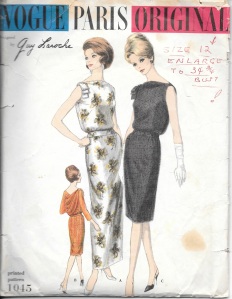
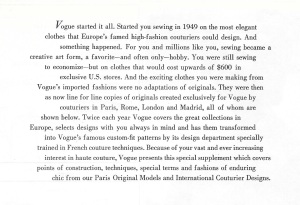
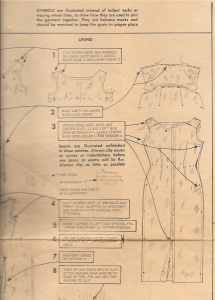





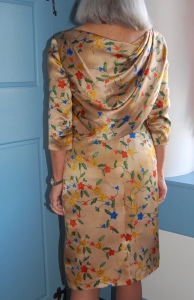


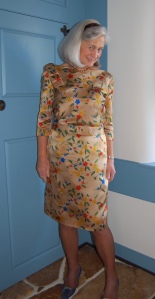
Wow this was a tough run, though the final photos look positively glowing! I love that draped back and the bow, very elegant. Congratulations on a difficult dress that turned out great! I like the alterations you opted for, they take nothing away from the original line, and suit you perfectly!
Thank you, Kathy. Now that the dress is finished, I am quite pleased with it, but it was a bear, as they say!
That back drape is stunning! As is the whole dress. I really like the fabric too.
Thank you, Heather! The fabric is an Italian silk which I purchased from Mendel Goldberg in NYC. It was lovely to sew with.
A question if you have time – do you have hints for sewing slippery fabrics? I’m lining a vest (oop Vogue 2450) with Silk charmeuse and either hand basting or using many pins. Thank you!
That is a great question, Heather. I have found that the more expensive the silk, the easier it is to handle. I’m not sure why this is. Perhaps the heft of the silk fibers? I have some relatively inexpensive silk charmeuse which was so slippery and uncooperative, that I finally stuck it away, probably never to be used! But I never have control issues with high end, expensive charmeuse. The crepe de chine is perfect for linings, as it is light weight and has a bit of a “pebbly” grain to it which really helps in handling. Hope this has helped?
Oh my goodness, so much work & time involved. I’m so glad you persevered with it. It’s beautifully finished now and luckily you still like it. Sometimes I don’t want to wear a piece that has given me grief. I have always found Vogue patterns a bit of a pain to follow as well. Thank you for sharing your mistakes, I don’t feel so bad about the stupid sewing things I’ve done. xxx
Sometimes it takes me a few days to “like” something if it has given me grief! But I must say, I was so happy when I finally put on the finished dress and it actually looked better than I thought it would. Whew! About those mistakes – we all make them. They teach us resilience!
Worth every painstaking minute! Beautiful and so interesting. Too bad we can’t see you in person. Great achievement!
Than you Margene! I could have done with a few less painstaking minutes! But such is life sometimes. Thank you for your comment!
You deserve all the champagne you want! It is absolutely gorgeous, as you are in it..
And I do love champagne! Than you, Debbie!
Absolutely stunning, just so perfect, just as the others said, definitely champagne-worthy, and so glad you and the dress are still friends after the tribulations.
Some friendships take more effort than others, but I have a feeling Miss Champagne and I will end up good friends! Thank you, Mery!
Lovely dress and beautiful choice of the fabric ! https://sewingchanel.weebly.com/
Than you very much!
Absolutely gorgeous! You should rightly be very proud. Best bit, it’s finished!
Here’s hoping you attend a glamorous, Champagne-laden event very soon! Happy New Year!
Thank you and Happy New Year to you, too!
Beautiful! I am glad your hard work was successful. I love the bateau neckline and the bow and you have the perfect fabric there!
Thank you, Linda. Thank goodness that neckline worked out – I like it, too!
Perfect dress for a cocktail party — where many people will first see you from the back…. They’ll look across the room and think, “What an interesting woman!”
Your comment sounds like the beginning of a short story. Thank you for your lovely thoughts!
A wonderful dress and you look simply stunning . Do let us all know when and where you first wear it .
I was heartened to read that you too suffer trials and tribulations ,in fact I opened your post as a respite from squinting at my unpicker as I had managed to catch the lining in a seam yet again . Why is it that some projects are plain sailing and a joy from beginning to end and yet others seem to be a test of ones patience and sanity ?
Thank you for another inspirational post !
It is rare when I have a project where I’m not pulling out threads and/or seams for one reason or another. But we keep coming back, don’t we? Thank you for commenting – I am so happy you liked the post!
You’ve really earned your glass or two of champagne with this project! Fabulous!
Or three or four glasses! Thank you so much!
I don’t know how you did it, but the dress is beautiful, Karen! I especially love the drape of the back. Congratulations to you!🥂
Thanks, Sarah! I wasn’t going to let this one get the best of me, and I’m glad I persevered! By the way, the 2018 RTW Fast is proving to be quite fun – thank you for all your huge efforts to put it all together!
As someone who has had her share of dresses which I thought would never be finished (and none of them were anything like as complicated as this) I can sympathize! The end result is beautiful. Congratulations, and enjoy your champagne!
Thank you, and thank you for reassuring me that others of us also deal with projects that are seemingly interminable!
What a beautiful dress. The bow and the drape back are perfect. Break out the champagne!
And so I will! Cheers to you and to me!
What a beautiful dress! Asymmetrical bodices can be so confusing. The drape back and tailored bow are worth every minute and you certainly deserve champagne!
You know, I think what was so confusing was that it is the back of the dress which is asymmetrical, not the front. Does that make sense? Anyway, I feel more “accomplished” and knowledgeable having this one under my belt!
It looks great. I have really similar looking pattern from burda from 1961 I intend to sew since years. Probably inspiered from this pattern
Thank you! Hopefully you will be inspired to make your Burda pattern now?
Now that we’ve marveled agape at the dress, a word about the pattern history. Your research is always so interesting. Tho he designed a wide range of beautiful things – coats & suits & mens’ ties – this is surely one of the best, probably the best, pattern. His Desses draping influence is still pronounced tho with his flair for lines and, as you say, interesting architecture. I don’t think there was or will be a time when this dress is out of style. Just think, if Vogue had made a pattern of this dress just a few years earlier it wouldn’t have had printing on it, just the holes the older patterns had. Yes, Karen, you may have just completed the best pattern ever, as well as made top notch decisions about fabric and fit.
Other styles are spectacular but only on those with a figure like Sophia Loren, but this style is feminine and pretty and smashing for many ladies.
Oh, Mery, you always make me feel so flattered with your comments! I find the history behind these patterns to be so fascinating, but I know not everyone shares my enthusiasm, so thank you for being a kindred spirit!
I’ve done the whole ‘flip the underlining piece’ thing far too many times recently… it’s a horrible realisation! What a beautiful dress though, so many lovely details. That back drape is a fabulous surprise, and I think you did a great job with reducing the blouson effect – the proportions you’ve got here look great 🙂
So happy to know I am not the only one getting confused with my underlinings! What a momentary nightmare that was, but all is well that ends well, thank goodness! Looking forward to seeing your latest Marfy creation!
Just gorgeous! Thanks for allowing us to follow along the missteps in construction. I agree that sometimes vintage patterns have much more complicated steps than most modern styles. I’m sure it’s a satisfying feeling to have solved all the problems and produced such a beautiful, flattering dress. I love the draping and tailored shoulder bow. Having shopped in MG, this wasn’t about to become an unfinished object.
No, one doesn’t want to relegate any MG fabric to the “ugh” pile. Although I had my worries about how this dress would turn out, I knew I would stick with it until I had it right, and I must say I am really pleased.
So lovely. The fabric is gorgeous, and the back drape is stunning. I have to echo what witness2fashion said about the effect of this dress and add ” oooh la la!” This is no ordinary dress. I think it would be only right if a nice bottle of champagne ended up in your shopping bag…
Thank you, Jen! Now I am just waiting for a champagne-laden invitation!
Very elegant! the draped back and the bow are beautiful! Congratulations, great job!!